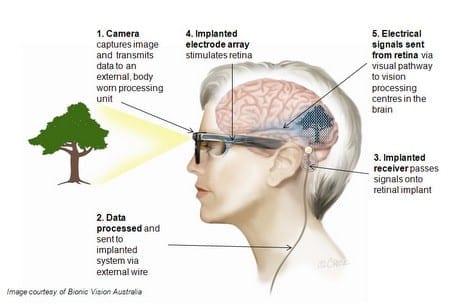“These results have fulfilled our best expectations”
In a major development, Bionic Vision Australia researchers have successfully performed the first implantation of an early prototype bionic eye with 24 electrodes.
Ms Dianne Ashworth has profound vision loss due to retinitis pigmentosa, an inherited condition. She has now received what she calls a ‘pre-bionic eye’ implant that enables her to experience some vision. A passionate technology fan, Ms Ashworth was motivated to make a contribution to the bionic eye research program.
After years of hard work and planning, Ms Ashworth’s implant was switched on last month at the Bionics Institute, while researchers held their breaths in the next room, observing via video link.
“I didn’t know what to expect, but all of a sudden, I could see a little flash…it was amazing. Every time there was stimulation there was a different shape that appeared in front of my eye,” Ms Ashworth said.
Professor Emeritus David Penington AC, Chairman of Bionic Vision Australia said: “These results have fulfilled our best expectations, giving us confidence that with further development we can achieve useful vision. Much still needs to be done in using the current implant to ‘build’ images for Ms Ashworth. The next big step will be when we commence implants of the full devices.”
Professor Anthony Burkitt, Director of Bionic Vision Australia said: “This outcome is a strong example of what a multi-disciplinary research team can achieve. Funding from the Australian Government was critical in reaching this important milestone. The Bionics Institute and the surgeons at the Centre for Eye Research Australia played a critical role in reaching this point.”
Professor Rob Shepherd, Director of the Bionics Institute, led the team in designing, building and testing this early prototype to ensure its safety and efficacy for human implantation. Cochlear technology supported aspects of the project.
Dr Penny Allen, a specialist surgeon at the Centre for Eye Research Australia, led a surgical team to implant the prototype at the Royal Victorian Eye and Ear Hospital.
“This is a world first – we implanted a device in this position behind the retina, demonstrating the viability of our approach. Every stage of the procedure was planned and tested, so I felt very confident going into theatre,” Dr Allen said.
The implant is only switched on and stimulated after the eye has recovered fully from the effects of surgery. The next phase of this work involves testing various levels of electrical stimulation with Ms
Ashworth.
“We are working with Ms Ashworth to determine exactly what she sees each time the retina is stimulated using a purpose built laboratory at the Bionics Institute. The team is looking for consistency of shapes, brightness, size and location of flashes to determine how the brain interprets this information.
“Having this unique information will allow us to maximise our technology as it evolves through 2013 and 2014,” Professor Shepherd said.








